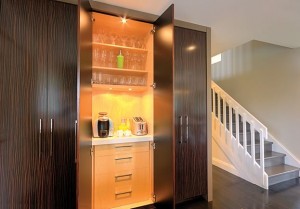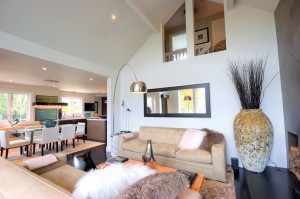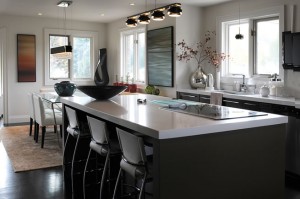What would Granny say?
Sleek and sexy, this young couple’s country kitchen simmers with urban chic.
“I really believe country living doesn’t have to include plaid curtains and rooster tea towels,” says Heidi Baufeldt. And indeed, this conviction is reflected in both her own country home and in her professional life.
Two years ago, when Heidi took over as manager of Granny Taught Us How, a country emporium and home décor store founded by her mother Maureen in 1978 in the hamlet of Violet Hill, Heidi decided to introduce a “modern elegance” to the store’s traditional country inventory. Now, the hugely successful Heidi’s Room occupies the back quarter of the store and its collection of contemporary accessories, furniture and art has livened up the shop’s country look.
“There wasn’t anything up here for contemporary people, so I brought in what the city offers – downtown modern –– to show people how they can add a few contemporary pieces to their home and suddenly have it look new and fresh.”
At 38, her views have some authority. Growing up with parents whose talent for period restoration and antiques was the source of many well-read magazine features, Heidi speaks highly of their passionate eye for detail and history – clearly she learned well – but her own taste leans toward contemporary design.

Abracadabra – With a now-you-see-it-now-you-don’t magic, the day-to-day paraphernalia of a family kitchen disappear behind Roman’s finely-crafted macassar ebony cabinetry. Photo by Brad Gosse.
Both she and her husband, fine cabinetry artisan Roman Altmann (whom Heidi describes as “brilliantly talented”), are drawn to the clean lines and open feel of the modern look. In recent years they bought, gutted and redesigned an old A-frame chalet-style house in the hills of Mulmur, creating a stunning and airy contemporary interior that walks the talk.
“While most people dream of a cottage, we dreamt of a condo,” says Heidi. “We have the best of both worlds here. We love the city, but here we can look out our windows and see deer eating the shrubs.”
No period pine, no hand-hooked rugs, no Restoration Hardware, their kitchen simmers with a sleek sophistication and urban chic that by no stretch of the imagination is related to traditional country, yet is classic in its own right.
An integral part of the main floor’s open-concept design, the kitchen’s clutter-free approach is Zen in its tranquility. With a now-you-see-it-now-you-don’t magic, the day-to-day paraphernalia of a family kitchen disappear behind Roman’s stunningly beautiful macassar ebony cabinetry. The floor-to-ceiling storage units feel and look more like fine furniture than kitchen cupboards.
“There is no such thing as clutter in contemporary design,” explains Heidi, “so the eye flows effortlessly through the space.” This is the critical element that makes the kitchen’s atmosphere so powerful. Heidi expresses it in visceral terms: “There is an instant sense of calm and tranquility for me.”
It is the perfect antidote to the young couple’s busy lives. Roman runs an established high-end cabinetry business that has him in Toronto much of the time (romanaltmann.com), and Heidi manages both the store and her mother’s popular Mrs. Mitchell’s Restaurant across from it. Too often they find themselves “working 80-hour weeks.”
Roman’s innovative design contributes to the sense of calm. The look is seamless. The sink is mounted under the counter, the glass stove-top flush to the counter, the push-button exhaust fan disappears when not in use, the wine fridge and dishwasher are built into the island, the refrigerator is panelled to match the cupboards. Everything is flush, nothing protrudes, nothing sits out on the counters, except an occasional accent piece.
All dishware and pots and pans are stored in drawers (much easier to find and reach than in deep cupboards). Small appliances stay stowed behind Roman’s cabinetry or in soft-slide drawers in the island. There are no floating upper cupboards. Nothing impedes the eye from moving through the space in a smooth and continuous flow.
“It was important when we designed the space to keep a visual flow,” explains Heidi. “The lines are clean right down to the hardware on the cabinets and the chairs at the table and the island. The chairs are not above counter height, so they don’t break the flow.”
To visually balance the large island they placed a simple glass dining table adjacent to it, “so the entire space didn’t feel weighted down.” White walls (Benjamin Moore Cloud White), white counters (man-made Silestone – an extremely hard surface with an antibacterial protection and uniform colour consistency), dark wood floors (recycled from a country and western bar in Barrie, sanded and re-finished by Roman), and dark cabinets (macassar ebony).
The dark/light contrast “can make the room feel very masculine and cold,” admits Heidi. “It’s the accessories and artwork that add life and a touch of femininity to our space.”

With 23 pot lights throughout the main floor, as well as the lighting fixtures, six dimmers control different areas of the lighting. Photo by Brad Gosse.
Those accessories, like the light fixture over the dining table with its crystal drops, also add some sophisticated dazzle. “That’s our ‘bling’,” says Heidi. “I’m not a girlie-girl, but I love sparkle. The light fixtures are the jewellery.” The brushed-nickel light fixture over the island provides another sensual accent and, like all the lighting, is on dimmers.
“It’s a fight we have all the time,” says Heidi. “Roman likes full light, I like mood light.” With 23 pot lights throughout the main floor, as well as the lighting fixtures, their compromise is to have six dimmers that control different sections of the lighting. “The lights go up and down,” she admits wryly, “but eventually we find a place we can agree on.”
Using dimmers adds ambience. “Lighting can make the mood,” says Heidi. “Dimmers give the island quite a loungey feeling at parties, which I like.”
Whether for cooking, conversation or cocktails, the many lighting moods of the island make it the natural gathering spot for entertaining. Which makes the two years they spent living in the basement with a microwave and toaster while Roman gutted and reinvented the upstairs all the more delicious.
Loungey, sleek, metropolitan: What would Granny say?









